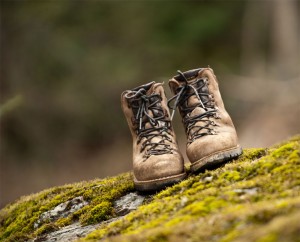

What do the old boots have to do with building? Please bear with me. I bought the boots pictured at right 20 years ago. At the time, they seemed very expensive–say $200. My Dad and I were on a fly fishing trip, and I needed a new pair of hiking boots. I didn’t have a lot of money, (and still don’t) but I chose to buy the Italian-made boots versus a less expensive option. Over the ensuing 20 years, I replaced the laces, and hiked a lot of miles. Let’s calculate my cost per year as $10 ($200 / 20 years).
Now suppose I’d bought the cheapest pair for $75, and suppose they lasted 5 years before wearing out. My cost per year would be $15 ($75 / 5 years).
Over 20 years, my cost for quality boots would be $200 (plus laces).
Over 20 years, my cost for cheap boots would be $300 (50% more expensive).
Now, suppose we enter a period of higher than normal inflation. If we factor in inflation at 8.27% a year, those “cheap” boots would now cost $600 over the 20 years–three times the cost of the “expensive” choice.
My point is that quality is almost always less expensive in the long-run, and that initial price does not equal total cost. Our clients know this. They always pause, and nod their heads knowingly when they notice this plaque in our office:

The Swiss have a saying, “Build it once”.
There’s another benefit to quality—you appreciate and enjoy your possessions more. Buy something serviceable but unremarkable, and it disappears. You simply don’t notice it any longer—like a battery powered clock on your wall. A family Grandfather clock is a different story. You appreciate it weekly—as you gently wind the mechanism and notice the 1878 date of manufacture and picture your father doing the same task every Sunday afternoon. Buy quality, and it becomes a friend, a loved possession.
At some point after owning something of quality for many years, you’ll shake your head in disbelief that it’s lasted so long. And here’s the funny thing—you won’t be able to remember what it cost.
This belief in quality is a big part of Sarah Susanka’s Not-So-Big-House philosophy. Design a smaller house, with higher quality design, materials & craftsmanship—to which I’d add, discipline yourself to make choices. You don’t need it all, and you’re not going to enjoy spending a big part of your life cleaning, maintaining, heating & cooling, storing, insuring and worrying about your things. Buy less things, but those you do buy, choose the best quality you can find. Choose quality over quantity and then discipline yourself to not buy or build everything you can afford. Don’t spend every dime you have or can borrow on quality. Buy only one pair of great boots, even if you can afford a second pair. Design your home so you have money left over at the end. That way it won’t be a burden, and your children will want it (that last piece of advice comes from my Dad–an attorney who specializes in Estate Planning and Probate Law). Follow this advice and you’ll have the time and money to experience a fuller and more meaningful life. You’ll be the one putting those boots on and going for a hike this weekend instead of the other person working Saturday and half of Sunday to make his or her mortgage payment this month.
Design your home so you have money left over at the end.
We hope to see changes to the way houses are built in America. There’s a lot of talk about a “New Normal”, and we hope to see a “Return to Quality”. Our grandparents believed in quality. They paid more for something made in the USA, of good design and materials, and bought it once. Their possessions are our prized antiques today. We’re optimistic that these difficult times will indeed usher in a “New Normal” in building, and that more people will choose to build a high-quality timber frame, more energy efficient, smaller and sustainable homes–homes that will be loved, and taken care of for a hundred years or more.
Many people believe both inflation and higher energy costs lie ahead. Building a somewhat smaller, meticulously designed home with high quality materials and craftsmanship that is even more energy efficient than you think is required…and that doesn’t take every dollar you have…may turn out to be one of the smartest and most enjoyable investments you can make in the coming years.
Best Regards,
Eric Morley, Founder